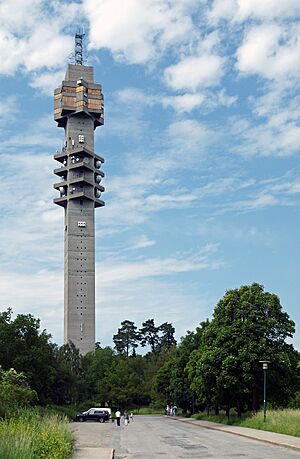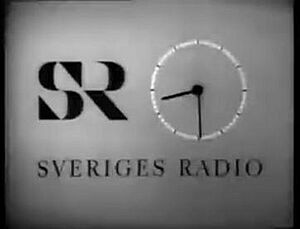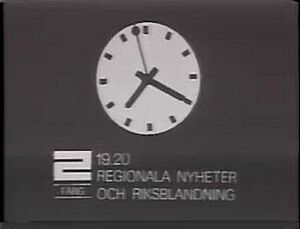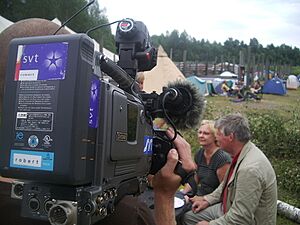Sveriges Television facts for kids
 |
|
| Type | Public television broadcaster |
|---|---|
| Country | Sweden |
| Availability | National |
| Founded | 1956 (as Radiotjänst) by Sveriges Radio |
| Motto | Hela Sveriges Television |
| Market share | none |
| Broadcast area | Sweden |
| Area | Europe |
| Parent | Foundation Management for SR, SVT, and UR |
| Key people |
|
| Launch date | 4 September 1956 |
| Former names | Radiotjänst (1956–1957) Sveriges Radio TV (1957–1979) |
| Channels | SVT1, SVT2, SVT24, SVT Barn, Kunskapskanalen |
| Online | SVT Nyheter |
| Other broadcast languages | Ođđasat (Northern Sámi) Uutiset (Finnish) Nyhetstecken (Swedish sign language) |
| Affiliates | European Broadcasting Union |
| Language | Swedish and a variety of minority languages. |
Sveriges Television AB, often called SVT, is Sweden's national public television broadcaster. It also runs a popular news website. SVT is funded by a special tax on personal income. Before 2019, it was paid for by a TV licence fee. The way SVT works is similar to the BBC in the United Kingdom.
SVT is a company owned by an independent foundation. This foundation also owns two other public broadcasters: Sveriges Radio (for radio) and Sveriges Utbildningsradio (for educational programs). The foundation's board has 13 politicians chosen by the Swedish government. These politicians then pick the people who run SVT.
SVT and Sveriges Radio used to be one company. But since 1979, they have been separate companies. SVT was the only TV broadcaster in Sweden from 1956 until 1992. That's when a private channel called TV4 started broadcasting. SVT is not allowed to show advertisements, except for sponsors of sports events. SVT is still the biggest TV network in Sweden. It reaches about 36.4% of all TV viewers.
Contents
How Swedish Television Started
When radio broadcasting began in Sweden in the 1920s, it followed a model like the British Broadcasting Company. It was a monopoly, meaning only one company, AB Radiotjänst, could broadcast. It was funded by a licence fee. The government owned the transmitters.
Test TV broadcasts started in June 1954. The first ones were on October 29, 1954, in Stockholm. In 1956, the Swedish parliament, called the Riksdag, decided that TV broadcasting should continue for good. On September 4, Radiotjänst began official broadcasts. A TV licence fee for TV owners started in October 1956.
Regular TV shows began in 1957. Radiotjänst changed its name to Sveriges Radio (SR). The government and the press shared ownership of the company.
In 1958, the first news program, Aktuellt, was broadcast. People often talked about adding a second TV channel in the 1960s. This led to the launch of TV2 on December 5, 1969. The first channel became TV1. The idea was for the two channels to compete in a friendly way within the same company.
The main building for Sveriges Television in Stockholm opened in stages. The first part opened on October 30, 1967. The second part, which was very large, opened on December 5, 1969. This was the same day TV2 started.
In 1970, the first regional program, Sydnytt, started from Malmö. More regional news programs began in 1972. By 1987, the whole country had regional news.
News programs were changed when TV2 started. Aktuellt was replaced by TV-nytt. This program handled the main news at 7:30 PM on TV1. In 1972, the news was changed again. Rapport moved to 7:30 PM on TV2. Aktuellt came back for 6:00 PM and 9:00 PM on TV1. These times mostly stayed the same for many years.
Color TV broadcasts started in 1966. Regular color shows began in 1970. Teletext, which showed text information on screen, started in 1978.
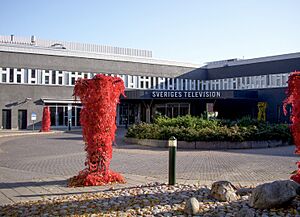
At the end of the 1970s, Sveriges Radio was reorganized. From July 1, 1979, Sveriges Radio became the main company for four smaller companies:
- Sveriges Riksradio (for national radio)
- Sveriges Lokalradio AB (for local radio)
- Sveriges Utbildningsradio (for educational shows)
- Sveriges Television (SVT) for TV.
SVT was in charge of all TV broadcasting, except for educational programs. The name SVT was chosen because "STV" was already used by Scottish Television.
In 1987, the two TV channels were reorganized. TV1 became Kanal 1. It showed almost all programs made in Stockholm. TV2 included ten regional areas and the Rapport news team.
Stereo sound became permanent in 1988. That year, a channel called SVT World started in southern Finland. It showed SVT programs for Swedish-speaking people there. This channel later expanded to all of Europe and then worldwide.
In 1992, the Riksdag decided to reorganize Sveriges Radio again. It split into three separate companies. From 1994, they were owned by three independent foundations. These foundations later merged into one.
In 1990, TV usually started at 4:00 PM and ended before midnight. In the 1990s, TV hours increased. Reruns were added in the afternoon, along with morning shows and lunchtime news. SVT also faced competition from new private channels. TV3 was the first channel to break SVT's TV monopoly in Sweden. In 1992, TV4 started broadcasting across the country. TV4 soon became the most-watched channel in 1995.
In 1996, the channels were reorganized again. Kanal 1 and TV2 were renamed SVT1 and SVT2. The first season of Expedition: Robinson (the original Swedish version of Survivor) was shown in 1997.
Digital TV broadcasts began in 1999. SVT started six new channels: the news channel SVT24 and five regional channels. In 2000, the news teams were reorganized. Aktuellt, Rapport, and SVT24 all came under one central news team.
In 2001, SVT introduced a new logo and new program schedules. SVT1 became the main channel with higher ratings. SVT2 focused on more specific programs. The main news programs switched channels. Aktuellt moved to SVT2, and Rapport moved to SVT1.
Regional channels closed in early 2002 and were replaced by SVT Extra. In December 2002, a new channel called Barnkanalen started showing children's programs during the day. On February 24, 2003, SVT24 and SVT Extra became 24, a channel for news and sports. Also in 2003, all SVT channels became free to watch on digital TV.
On June 25, 2003, SVT broadcast its first program with surround sound. The show was Allsång på Skansen. In November 2004, SVT added audio options that read out subtitles. The knowledge channel Kunskapskanalen started broadcasting in September 2004.
The old analogue TV transmitters were turned off starting in 2005. By 2007, all analogue broadcasts from SVT had stopped.
SVT started offering programs online for on-demand viewing in February 2006. Regular high-definition (HD) broadcasting began on the SVT HD channel on October 22, 2006. On August 25, 2008, new logos and channel looks were introduced. Barnkanalen was renamed SVTB, and 24 went back to its old name, SVT24. SVT1 also started showing regional news.
SVT has hosted the Eurovision Song Contest many times: in 1975, 1985, 1992, 2000, 2013, 2016, and 2024.
In 2018, the Riksdag decided to change how SVT was funded. Instead of a TV licence fee, it would be paid for by a public service fee based on personal income tax.
Popular TV Shows on SVT
News Programs and Reporting
News programs are a very important part of SVT. Since 1972, there have been two main news programs: Rapport and Aktuellt. These two programs used to have separate teams. But in 2000, they merged with the new SVT24 channel to form one news organization. They still kept their different names. Rapport has become the main news program.
The main national news shows are Rapport, broadcast at 6:00 PM and 7:30 PM. Aktuellt provides more in-depth news at 9:00 PM. Shorter news updates are shown throughout the day on SVT1, SVT2, and SVT24. These are called SVT Nyheter. SVT also offers video news online through Play Rapport.
SVT provides news in different minority languages. These include Uutiset in Finnish, Nyhetstecken in Swedish Sign Language, and Ođđasat in Northern Sami. There are also special versions of Sverige idag in Meänkieli and Romani.
There are also regional news programs:
- on SVT1 at 6:33 PM on weekdays and 6:10 PM on Sundays.
- also at 7:55 PM daily, except Saturdays.
- on SVT2 at 9:46 PM on weekdays and 9:25 PM on Fridays.
- ABC from Stockholm (for Stockholm and Uppsala)
- Gävledala from Falun (for Dalarna and Gävleborg)
- Mittnytt from Sundsvall (for Västernorrland)
- Nordnytt from Luleå (for Norrbotten)
- Östnytt from Norrköping (for Östergötland, Södermanland and Gotland)
- Smålandsnytt from Växjö (for Kronoberg, Kalmar and Jönköping)
- SVT Nyheter Jämtland from Östersund (for Jämtland)
- SVT Nyheter Väst from Gothenburg (for Västra Götaland and Halland)
- Sydnytt from Malmö (for Skåne and Blekinge)
- Tvärsnytt from Örebro (for Örebro and Västmanland)
- Värmlandsnytt from Karlstad (for Värmland)
- Västerbottensnytt from Umeå (for Västerbotten)
In November 2023, SVT worked with many other media groups and journalists from around the world. They created a report called 'Cyprus Confidential'. This report looked into financial networks and showed how important it is for information to be open and clear.
Fairness in Reporting
A study in 1999 looked at how journalists at SVT and Sveriges Radio leaned politically. It found that more of them supported certain parties compared to the general public. However, the study also said that journalists' personal political views did not affect their work. News stories were treated the same, no matter what the journalist's politics were. Another study in 2006 compared SVT's news program Rapport to five large newspapers. It found that Rapport's election coverage was the most balanced of all.
Entertainment Shows
Entertainment shows on Fridays and Saturdays, along with popular sports, attract the largest audiences.
- Melodifestivalen (1959–present): This is Sweden's national competition to choose a song for the Eurovision Song Contest. The final usually has about four million viewers.
- Expedition Robinson (1997–2004, 2009–2012): This was the first Swedish version of the Survivor reality TV show. SVT was the first network to broadcast it in 1997. It was very popular in Sweden. The show later moved to other channels.
- På spåret (1987–present): A popular entertainment show where celebrities answer questions about different places. A very fast video of a train journey towards a location is shown. The sooner contestants stop it, the more points they get. The show's name means "on the track." It is one of the few original Swedish show ideas and has been shown in other countries.
- Så ska det låta (1997–present): The Swedish version of The Lyrics Board. It has often reached more than three million viewers.
- Allsång på Skansen (1979–present): A popular summer show with Swedish folk music sing-alongs. It is broadcast live from Skansen in Stockholm. This sing-along tradition started in 1935.
- Antikrundan (1989–present): The Swedish version of Antiques Roadshow. It often attracts about two million viewers.
Sveriges Television has hosted the Eurovision Song Contest many times.
Drama Series
SVT produces many types of drama shows.
- Rederiet (1992–2002) was one of the most popular soap operas in Sweden.
Regional Programs
Regional content is mostly news. It is broadcast on SVT1 and SVT2. There are eighteen regional news programs. They are shown on SVT1 on weekdays and Sundays, and on SVT2 on weekdays. There are no regional news shows on Saturdays.
Children's Programs
Kalles klätterträd started on Sveriges Television in 1975. It became one of the most popular children's programs of the 1970s. The children's block Bolibompa was broadcast every day at 6:00 PM on SVT1. It later moved to SVTB in August 2008.
International Programs
SVT also shows programs from other countries. These are mainly from the United States, the United Kingdom, and other Nordic countries. They are usually shown in their original language with Swedish subtitles.
The only time programs are widely dubbed (voices changed to Swedish) is for shows made for very young children who cannot read yet. For some programs, viewers can also turn on "talking subtitles." This is where someone reads the subtitles aloud.
In 2005, about 33% of new programs shown were from other countries. Of all the programs SVT bought (including Swedish ones not made by SVT), 27% came from the United States, 22% from the United Kingdom, and 13% from other Nordic countries.
SVT often works with other Nordic public broadcasters through Nordvision. This means many Danish, Norwegian, Icelandic, and Finnish programs are shown on SVT. In return, Swedish programs are shown on channels in those countries.
SVT Channels
SVT has five main channels that broadcast in Sweden:
- SVT1 – This is the main channel with a wide range of programs and regional content. The 10 most-watched Swedish TV shows in 2006 were on this channel. SVT1 HD also broadcasts in high definition.
- SVT2 – This channel has more specific programs, focusing on culture, current events, and documentaries. SVT2 HD also broadcasts in high definition.
- SVT Barn (SVT Children) – This channel shows programs for children and pre-teens.
- Kunskapskanalen (The Knowledge Channel) – This channel broadcasts debates, seminars, and documentaries. It works with UR.
- SVT24 – This channel shows reruns of programs from SVT1 and SVT2 in the evening. It also has continuous news updates during the night. It shares its broadcast time with SVT Barn.
SVT also had a special channel for events called SVT Extra. It was not used often. In 2006, SVT launched SVT HD, a high-definition channel.
Most SVT channels are available across Sweden through digital TV. They can also be received from satellites. Cable TV companies must offer four SVT channels for free.
SVT World, which was a mix of SVT channels, used to be broadcast by satellite and online. It was also a regular TV channel in Swedish-speaking parts of southern Finland. SVT World did not show bought programs like movies or sports. This channel closed in April 2017.
SVT's website, svt.se, is considered a channel itself. SVT also has an on-demand service called SVT Play. Most programs made for SVT are available there. However, most non-news programs on SVT Play can only be watched in Sweden.
How SVT is Organized
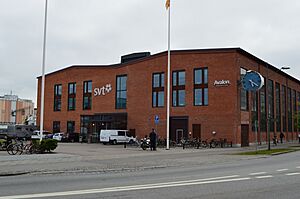
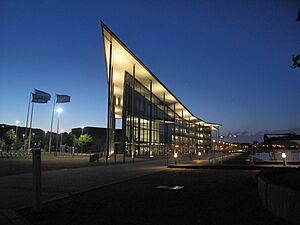
The head of SVT is a CEO, chosen by the board. The current CEO of SVT is Hanna Stjärne, who took over in 2015.
SVT is divided into eight main parts that make programs. Four of these are in Stockholm. The other four are in regional studios around the country:
- Malmö – SVT Syd (includes SVT Malmö and SVT Växjö)
- Gothenburg – SVT Väst (includes SVT Göteborg)
- Norrköping – SVT Mellansverige (includes SVT Falun, Dövas TV Leksand, SVT Karlstad, SVT Örebro and SVT Norrköping)
- Umeå – SVT Nord (used to be SVT Luleå, SVT Umeå and SVT Sundsvall)
These regional areas produce programs for the whole network. They also help with ten of the eleven regional news services shown daily on SVT1.
The parts based in Stockholm are:
- SVT Nyheter & Samhälle – for national news, current events, documentaries, and the regional news service ABC.
- SVT Sport
- SVT Fiktion – for drama, entertainment, youth, and children's programs.
- SVTi – for multimedia and online services.
Leaders of SVT
Here are some of the people who have led SVT:
Chairs of the Board of Directors
- Lennart Sandgren, 1978–1994
- Anna-Greta Leijon, 1994–2000
- Allan Larsson, 2000–2005
- Lars Engqvist, 2005–2011
- Göran Johnsson, 2011–2014
- Anna-Karin Celsing, 2014–2020
- Kia Orback Pettersson 2020–2024
- Christina Björklund, 2024–present
Chief Executive Officers
Before SVT was formed in 1978, TV broadcasting was managed by channel controllers.
- Magnus Faxén, 1978–1981
- Sam Nilsson, 1981–1999
- Maria Curman, 2000–2001
- Christina Jutterström, 2001–2006
- Eva Hamilton, 2006–2014
- Hanna Stjärne, 2014–present
How Many People Watch SVT
Since private TV channels started, SVT's total number of viewers has slowly gone down. Digital channels have also added more competition. The private channel TV4 became the most-watched station in 1995. It held that spot until 2002, when SVT1 became number one again. TV4 became the most-watched channel again in 2006.
The total number of viewers for SVT channels went from 50% in 1997 to 40% in 2005. SVT was the most-watched network in Sweden in 2006, with 38.3% of viewers. However, the three main private channels attract more viewers aged 15 to 24 than SVT's two main channels combined.
Audience Trust in SVT
A study in 2020 showed that trust in SVT programs varied among viewers. About 80-90% of viewers who supported liberal or left-leaning political parties had high trust in SVT. However, fewer viewers who supported conservative-leaning parties had high trust in SVT. For example, 60% of Christian Democrats supporters and 30% of Sweden Democrats supporters trusted SVT. This showed that SVT was a topic that divided opinions among viewers.
More About Swedish TV
- List of Swedish television channels
- Radiotjänst i Kiruna
- Sveriges Utbildningsradio
- Swedish Broadcasting Commission
- Teracom
- TV4
- Viasat
See also
 In Spanish: Sveriges Television para niños
In Spanish: Sveriges Television para niños


